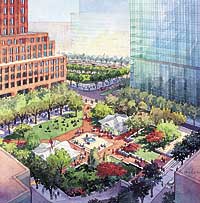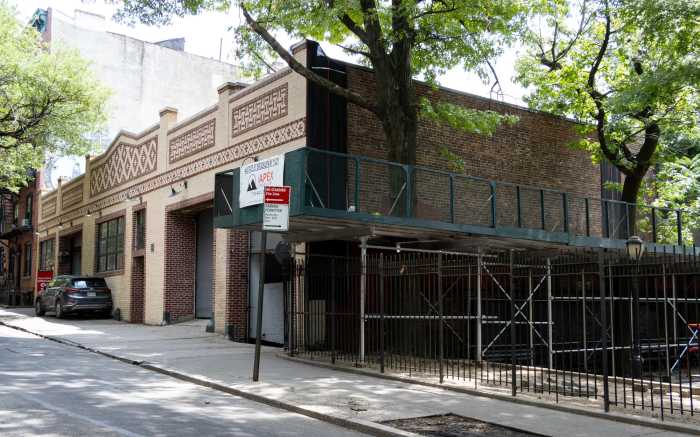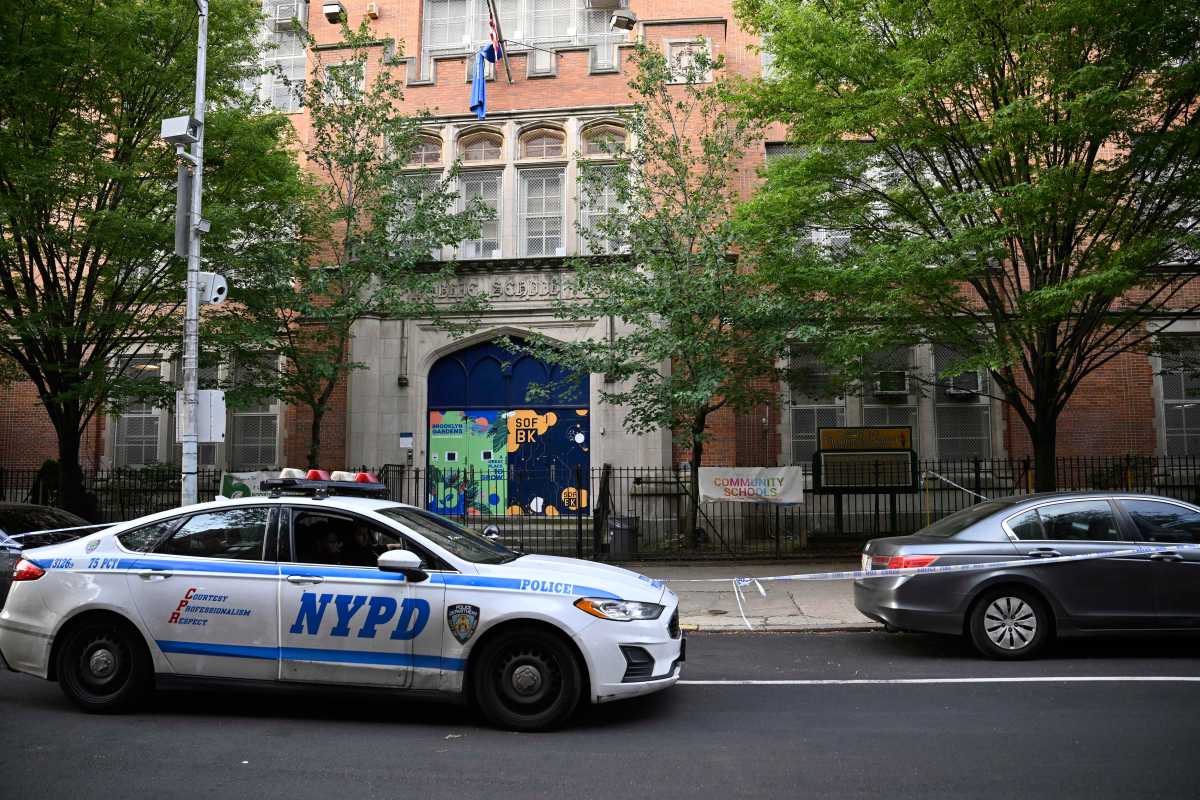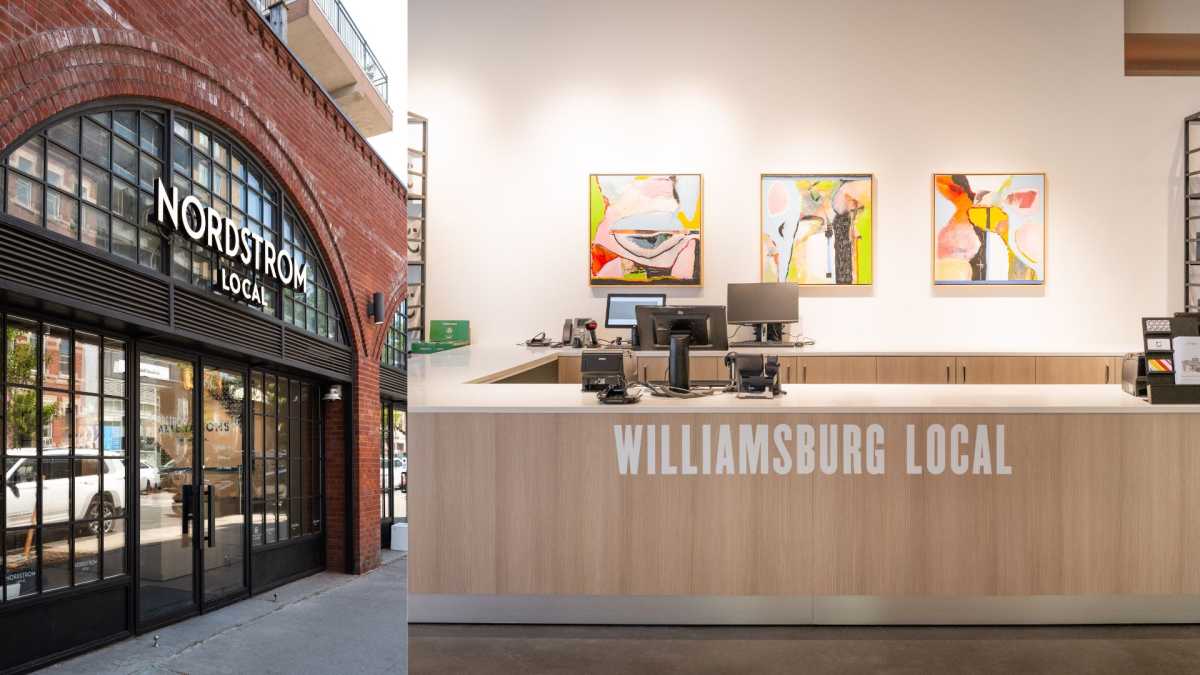The most complex rezoning plan in city history, which would convert Downtown
Brooklyn into a booming metropolis with soaring towers and require the
taking of seven acres of private land, is moving forward through the city
review process — without input from Community Board 2.
Following years of planning, months of discussion and a four-hour public
hearing, the Downtown Brooklyn board effectively removed itself —
and the communities it represents — from the process when it gathered
Tuesday night at Brooklyn Technical High School in Fort Greene to vote
on the multi-layered application.
That’s because most board members were baffled as to what exactly
they were voting on.
“The proposal was too big —why didn’t they break it down?”
asked board member Irene Van Slyke, who voted to adopt the recommendations
of CB2’s Land Use committee.
That panel effectively culled down a more than 210-page ULURP application
and its companion 3-inch-thick Draft Environmental Impact Statement into
a two-page report recommending that the board approve the upzoning of
the Downtown area to allow for sweeping towers but disapprove of eminent
domain takings of private property that would allow the city to seize
100 apartments, 130 commercial units and a college, all of which city
planners say is needed to achieve much of the specific development outlined
in the application.
Rather than—
•vote to recommend approval or rejection of the entire massive city
application, or
•vote individually on each of the application’s 22 independent
actions, or
•vote to recommend disapproval unless certain aspects of the plan,
like the eminent domain property takings, were removed,
—the board decided to cast just one vote on the Land Use committee’s
report.
Because they had to vote yes or no to a report that contained both approvals
and disapprovals, board members were confused as to precisely what their
vote would mean.
Following a brief discussion by board members about the plan, including
traffic concerns and the need to fully study the implications of such
a big build-out in conjunction with other developments around the area
(many of them enumerated on a satellite photo of greater Downtown Brooklyn
on the front page of last week’s Brooklyn Papers), the board voted
19-17, with three abstentions, in favor of adopting the committee’s
report.
But according to board rules, a majority of the board members in attendance
is required to pass a resolution.
With 36 board members voting, three (Gloria Andrews, Edward Carter and
Hemalee Patel) abstaining and one board member (Rachel Foster) actually
ducking the vote — she hid in the hallway saying she felt pressured
by the hundreds of vocal protesters, according to a source — there
were 40 board members in attendance. Therefore, 21 votes were needed to
adopt the committee report.
Thus, the committee’s report was rejected.
Adding to the strange happenings, before the final tally was counted,
Patel asked to change her vote from an abstention to an actual vote. Her
request was shot down by CB2 Chairwoman Shirley McRae.
Foster did not return telephone messages left on her cell phone.
Irene Van Slyke, a longtime community board member, jumped up and took
the microphone after the votes had been cast and McRae was still speaking.
“Now the borough president won’t understand what this vote means,”
she said.
“We just weren’t finished,” said Van Slyke, who is opposed
to most parts of the Downtown Plan.
She explained that a “yes” vote actually meant voting down eminent
domain portions of the plan and several street demappings that would make
way for larger development sites.
Located just blocks from the proposed Atlantic Yards site where developer
Bruce Ratner is looking to construct a $2.5 billion residential and commercial
village centered around a professional basketball arena to house his recently
purchased New Jersey Nets, some of the approximately 400 protesters who
packed the high school auditorium thought CB2 was actually voting on the
arena plan.
Draped in American flags and armed with placards and balloons they cheered
after it was announced that the board had failed to make a recommendation,
thinking that meant they decided to not approve the arena plan. Others
in attendance wanted the Downtown and arena plans considered together
and still others were protesting the eminent domain portions of the Downtown
Plan.
“There was a lot of misinformation,” said McRae, explaining
before the board adjourned that contrary to the belief of many, the board’s
vote had no bearing on the arena plan.
The two plans which cover adjacent areas and whose impact on each other
cannot be separated, are in fact linked physically, overlapping on the
site at Atlantic and Flatbush avenues where Ratner wants to build a 620-foot
office tower adjacent to a Nets arena.
For the most part, Ratner’s Atlantic Yards project will likely skirt
community board and city review by going through the much less rigorous
state review process.
The community board is the first stop along the approximately seven-month
city Uniform Land Use Review Procedure (ULURP) and is followed by public
hearings before and votes by the borough president, City Planning Commission
and City Council.
While the role of the board is purely advisory, its ULURP vote and recommendations
send a clear message to elected officials about the concerns and wishes
of the communities it serves.
Except in this case where it sends no message at all.
“I know they voted against the committee recommendation,” is
all Hardy Adasko, senior vice president of the city Economic Development
Corporation, would say when asked to interpret the vote.
Some feared that a vote against the committee recommendation could be
viewed as a vote in favor of eminent domain, since the committee had voted
down those portions of the plan.
“The community board has essentially taken no vote on anything,”
said CB2 member Ken Diamondstone, who made a motion before the vote to
consider each of the 22 actions and vote on them individually.
That motion was voted down by the board.
“It was strange that the meeting didn’t continue with some request
for another resolution,” said Diamondstone.
Asked afterwards why she did not take action to ensure the board adopted
some resolution or recommendation on the application or took another vote,
McRae said it was not her role to tell board members to make a motion.
Responding to the loss of 21,000 city jobs to New Jersey in the 1990s,
the Bloomberg administration announced the Downtown Brooklyn Plan last
April.
The mayor pledged to fund $100 million in infrastructure improvements
and construction over the next 10 years, but the project would still be
largely dependent on market conditions and the ability to lure business
and developers.
Critics have called the $100 million “chicken feed” and said
much more would be needed for traffic mitigation and subway construction
alone.
Just last week, as CB2 was gearing up to vote on the plan, Deputy Mayor
Dan Doctoroff sent a multi-page letter to the board outlining a number
of traffic mitigations the city would consider studying.
But many members said it was too little, too late and urged the city to
do the traffic studies before pushing ahead with the plan.
“Let’s do the birth control planning now, not after the baby
is born,” CB2 member Bill Harris wrote in a Jan. 28 letter to fellow
board members.
So what happens now?
The massive application goes to Borough President Marty Markowitz, who
was hosting a reception in honor of Bishop Nicolas DiMarzio, spiritual
leader of the Roman Catholic Diocese of Brooklyn Tuesday night and did
not attend the vote.
“Although the community board took no clear position on the Downtown
Plan many important issues were raised during the several committee and
general board meetings,” said Markowitz, adding, “I look forward
to hearing more about these issues.”
The next public hearing on the Downtown Plan will be hosted by Markowitz
on Feb. 18, at 6 pm, at Borough Hall.
“We have to have the borough president do the right thing,”
said Nancy Wolf, chairwoman of the CB2 Traffic and Transportation committee,
who is asking Markowitz to advocate for the committee’s extensive
list of recommendations with regard to the Downtown Plan..

























